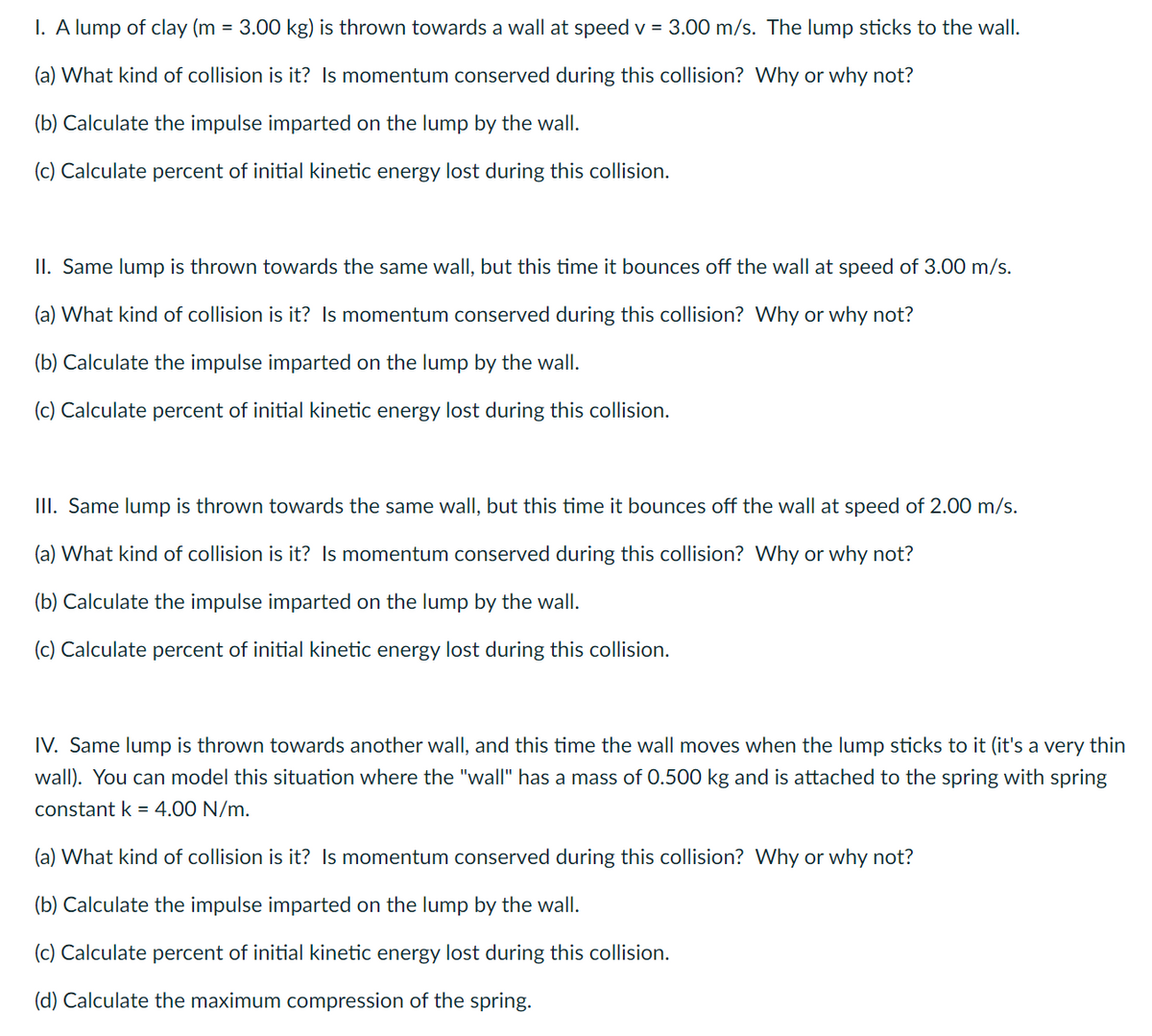IV. Same lump is thrown towards another wall, and this time the wall moves when the lump sticks to it (it's a very thin wall). You can model this situation where the "wall" has a mass of 0.500 kg and is attached to the spring with spring constant k = 4.00 N/m. (a) What kind of collision is it? Is momentum conserved during this collision? Why or why not? (b) Calculate the impulse imparted on the lump by the wall. (c) Calculate percent of initial kinetic energy lost during this collision. (d) Calculate the maximum compression of the spring.
IV. Same lump is thrown towards another wall, and this time the wall moves when the lump sticks to it (it's a very thin wall). You can model this situation where the "wall" has a mass of 0.500 kg and is attached to the spring with spring constant k = 4.00 N/m. (a) What kind of collision is it? Is momentum conserved during this collision? Why or why not? (b) Calculate the impulse imparted on the lump by the wall. (c) Calculate percent of initial kinetic energy lost during this collision. (d) Calculate the maximum compression of the spring.
College Physics
10th Edition
ISBN:9781285737027
Author:Raymond A. Serway, Chris Vuille
Publisher:Raymond A. Serway, Chris Vuille
Chapter6: Momentum And Collisions
Section: Chapter Questions
Problem 29P: a man of mass m1 = 70.0 kg is skating at v1 = 8.00 m/s behind his wife of mass m2 = 50.0 kg, who is...
Related questions
Question
Part 4 (IV) please

Transcribed Image Text:I. A lump of clay (m = 3.00 kg) is thrown towards a wall at speed v = 3.00 m/s. The lump sticks to the wall.
(a) What kind of collision is it? Is momentum conserved during this collision? Why or why not?
(b) Calculate the impulse imparted on the lump by the wall.
(c) Calculate percent of initial kinetic energy lost during this collision.
II. Same lump is thrown towards the same wall, but this time it bounces off the wall at speed of 3.00 m/s.
(a) What kind of collision is it? Is momentum conserved during this collision? Why or why not?
(b) Calculate the impulse imparted on the lump by the wall.
(c) Calculate percent of initial kinetic energy lost during this collision.
III. Same lump is thrown towards the same wall, but this time it bounces off the wall at speed of 2.00 m/s.
(a) What kind of collision is it? Is momentum conserved during this collision? Why or why not?
(b) Calculate the impulse imparted on the lump by the wall.
(c) Calculate percent of initial kinetic energy lost during this collision.
IV. Same lump is thrown towards another wall, and this time the wall moves when the lump sticks to it (it's a very thin
wall). You can model this situation where the "wall" has a mass of 0.500 kg and is attached to the spring with spring
constant k = 4.00 N/m.
(a) What kind of collision is it? Is momentum conserved during this collision? Why or why not?
(b) Calculate the impulse imparted on the lump by the wall.
(c) Calculate percent of initial kinetic energy lost during this collision.
(d) Calculate the maximum compression of the spring.
Expert Solution
This question has been solved!
Explore an expertly crafted, step-by-step solution for a thorough understanding of key concepts.
This is a popular solution!
Trending now
This is a popular solution!
Step by step
Solved in 7 steps with 3 images

Knowledge Booster
Learn more about
Need a deep-dive on the concept behind this application? Look no further. Learn more about this topic, physics and related others by exploring similar questions and additional content below.Recommended textbooks for you

College Physics
Physics
ISBN:
9781285737027
Author:
Raymond A. Serway, Chris Vuille
Publisher:
Cengage Learning

Principles of Physics: A Calculus-Based Text
Physics
ISBN:
9781133104261
Author:
Raymond A. Serway, John W. Jewett
Publisher:
Cengage Learning

Physics for Scientists and Engineers with Modern …
Physics
ISBN:
9781337553292
Author:
Raymond A. Serway, John W. Jewett
Publisher:
Cengage Learning

College Physics
Physics
ISBN:
9781285737027
Author:
Raymond A. Serway, Chris Vuille
Publisher:
Cengage Learning

Principles of Physics: A Calculus-Based Text
Physics
ISBN:
9781133104261
Author:
Raymond A. Serway, John W. Jewett
Publisher:
Cengage Learning

Physics for Scientists and Engineers with Modern …
Physics
ISBN:
9781337553292
Author:
Raymond A. Serway, John W. Jewett
Publisher:
Cengage Learning

Physics for Scientists and Engineers
Physics
ISBN:
9781337553278
Author:
Raymond A. Serway, John W. Jewett
Publisher:
Cengage Learning

Physics for Scientists and Engineers: Foundations…
Physics
ISBN:
9781133939146
Author:
Katz, Debora M.
Publisher:
Cengage Learning

Physics for Scientists and Engineers, Technology …
Physics
ISBN:
9781305116399
Author:
Raymond A. Serway, John W. Jewett
Publisher:
Cengage Learning